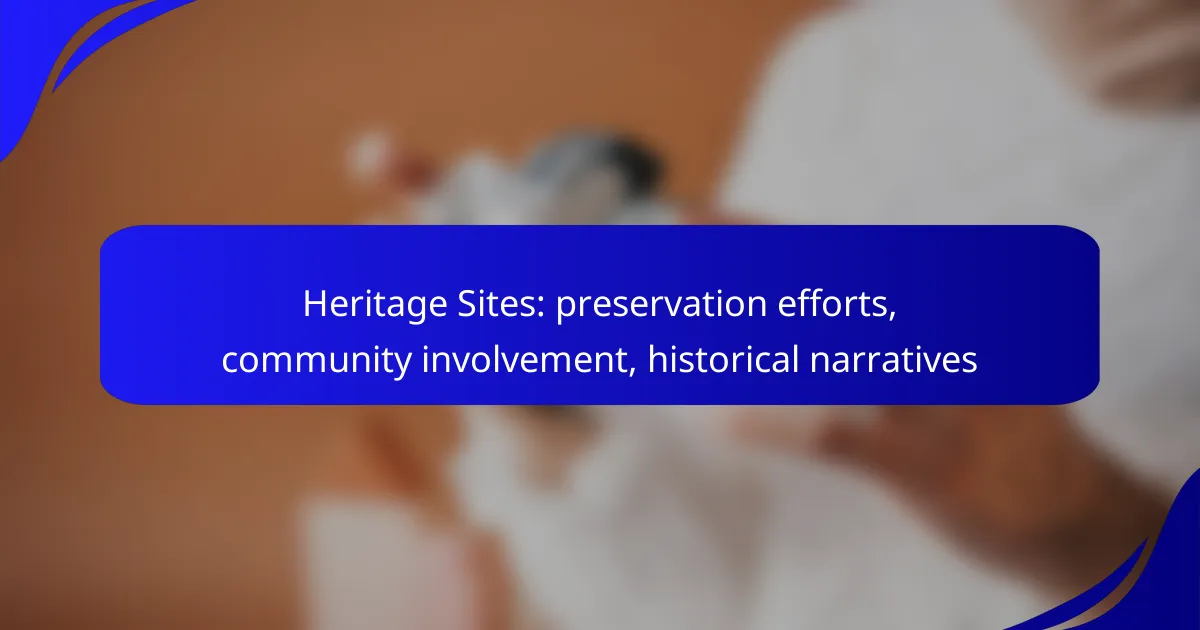Preservation of heritage sites in Australia relies on a collaborative approach that includes government regulations, community engagement, and innovative funding solutions. Local communities play a vital role in safeguarding these sites, fostering a sense of ownership while ensuring that the diverse historical narratives are honored and transmitted to future generations.

How are heritage sites preserved in Australia?
Heritage sites in Australia are preserved through a combination of government regulations, community involvement, funding from heritage organizations, and technological innovations. These efforts ensure that historical narratives and cultural significance are maintained for future generations.
Government regulations
The Australian government enforces various regulations to protect heritage sites, including the Environment Protection and Biodiversity Conservation Act. This legislation requires assessments for any development that may impact listed heritage sites, ensuring that their historical and cultural values are not compromised.
State and local governments also have their own heritage acts, which provide frameworks for identifying and managing heritage places. These regulations often include guidelines for restoration and maintenance, helping to preserve the integrity of these sites.
Community-led initiatives
Community involvement is crucial in the preservation of heritage sites, as local groups often lead initiatives to raise awareness and promote conservation efforts. These initiatives can include volunteer programs for site maintenance, educational workshops, and cultural events that celebrate local history.
Engaging the community fosters a sense of ownership and pride, encouraging individuals to advocate for the protection of their heritage. Successful examples include local heritage festivals and collaborative projects with schools to document historical narratives.
Funding from heritage organizations
Various heritage organizations provide funding and grants to support preservation efforts across Australia. These funds can be used for restoration projects, research, and educational programs aimed at promoting awareness of heritage sites.
Organizations such as the National Trust and state heritage councils often prioritize projects that involve community engagement or that demonstrate significant historical value. Applying for these grants typically requires a clear project proposal outlining the intended outcomes and benefits for the community.
Technological innovations
Technological advancements play a significant role in the preservation of heritage sites. Techniques such as 3D scanning and digital modeling allow for detailed documentation of structures, which can be invaluable for restoration efforts.
Additionally, the use of drones for aerial surveys and monitoring can help assess the condition of heritage sites over time. These technologies not only enhance preservation methods but also facilitate public engagement through virtual tours and interactive displays that showcase the site’s history.

What role does the community play in heritage site preservation?
The community plays a crucial role in preserving heritage sites by actively participating in their protection and maintenance. Local involvement not only fosters a sense of ownership but also ensures that historical narratives are honored and passed down through generations.
Volunteer programs
Volunteer programs are essential for engaging community members in heritage site preservation. These initiatives often involve activities such as cleaning, restoration, and maintenance of sites, allowing volunteers to contribute their time and skills. Many organizations offer training sessions to equip volunteers with the necessary knowledge about the site’s history and preservation techniques.
For example, a local heritage site may host monthly volunteer days where community members can join together to restore gardens or repair structures. This not only enhances the site but also strengthens community bonds.
Local advocacy groups
Local advocacy groups play a pivotal role in raising awareness about the importance of heritage site preservation. These organizations often work to influence policy decisions, secure funding, and mobilize public support for preservation efforts. They can also serve as a platform for community members to voice their concerns and ideas regarding local heritage.
Joining or supporting these groups can amplify community efforts, as they often organize campaigns and events that highlight the significance of preserving local history. Engaging with these organizations can lead to more effective advocacy and greater visibility for preservation issues.
Educational workshops
Educational workshops are vital for informing the community about heritage site preservation practices. These workshops can cover various topics, including the historical significance of the site, conservation techniques, and the impact of tourism on local heritage. By participating in these sessions, community members can gain valuable insights and skills.
For instance, a workshop might teach participants about traditional building methods used in a local heritage site, encouraging them to appreciate and advocate for the preservation of these techniques. Such knowledge not only empowers individuals but also fosters a collective commitment to safeguarding local heritage.

What are the historical narratives of Australian heritage sites?
Historical narratives of Australian heritage sites encompass the diverse stories and experiences that shape the nation’s identity. These narratives reflect the rich tapestry of Indigenous cultures, colonial histories, and architectural developments that have influenced Australia over time.
Indigenous histories
Indigenous histories are foundational to understanding Australia’s heritage. These narratives highlight the connection of Aboriginal and Torres Strait Islander peoples to the land, showcasing their traditions, languages, and spiritual beliefs that date back tens of thousands of years.
Preservation efforts often involve collaboration with Indigenous communities to ensure their stories are accurately represented. This can include the protection of sacred sites and the inclusion of Indigenous perspectives in heritage management practices.
Colonial impacts
Colonial impacts significantly shaped the historical narratives of Australian heritage sites. The arrival of European settlers in the late 18th century led to profound changes in land use, social structures, and cultural practices, often resulting in the displacement of Indigenous populations.
Understanding these colonial narratives is crucial for acknowledging past injustices and fostering reconciliation. Heritage sites often serve as reminders of this complex history, prompting discussions about the legacies of colonization and the ongoing effects on contemporary society.
Architectural significance
Architectural significance in Australian heritage sites reflects the evolution of building styles and techniques influenced by both Indigenous and colonial practices. Notable examples include Victorian-era buildings, modernist structures, and Indigenous architecture that showcase the diversity of Australia’s architectural heritage.
Preservation of these sites often involves adhering to national and local heritage guidelines, which aim to maintain the integrity of historical structures. Engaging the community in these efforts can enhance appreciation and foster a sense of ownership over local heritage.

What frameworks support heritage site preservation?
Heritage site preservation is supported by various frameworks that establish criteria for protecting and managing these sites. These frameworks guide governments and organizations in recognizing, maintaining, and promoting cultural and historical significance.
National Heritage List criteria
The National Heritage List (NHL) criteria are established by individual countries to identify sites of national significance. Typically, these criteria assess factors such as historical importance, architectural uniqueness, and cultural value. For example, a site may be included if it demonstrates a strong association with significant events or figures in a nation’s history.
Countries often have specific guidelines outlining the nomination process, which may include public consultations and expert evaluations. In the United States, for instance, the National Register of Historic Places employs criteria that emphasize integrity and significance, ensuring that only worthy sites receive recognition.
UNESCO World Heritage criteria
The UNESCO World Heritage criteria are internationally recognized standards for identifying sites of outstanding universal value. To be considered, a site must meet at least one of ten criteria, which include representing a masterpiece of human creative genius or exhibiting an important interchange of human values. This global perspective encourages the preservation of diverse cultural and natural heritage.
To pursue UNESCO designation, a country must submit a nomination dossier that includes detailed documentation and evidence supporting the site’s significance. The evaluation process involves expert assessments and recommendations from the International Council on Monuments and Sites (ICOMOS) or the International Union for Conservation of Nature (IUCN). Successful nominations can enhance tourism and funding opportunities, making preservation efforts more sustainable.

How do preservation efforts impact local economies?
Preservation efforts significantly boost local economies by enhancing tourism and creating jobs. By maintaining and promoting heritage sites, communities can attract visitors, which in turn generates revenue and employment opportunities.
Tourism growth
Heritage preservation often leads to increased tourism, as visitors seek authentic experiences tied to local culture and history. Well-preserved sites can draw thousands of tourists annually, contributing to local businesses such as hotels, restaurants, and shops.
For example, a restored historical district can see a rise in foot traffic, leading to higher sales for local vendors. Communities can capitalize on this by organizing events or festivals that celebrate their heritage, further boosting visitor numbers and spending.
Job creation in conservation
Preservation initiatives create job opportunities in various sectors, including conservation, tourism management, and education. These roles can range from skilled trades such as masonry and carpentry to positions in visitor services and cultural interpretation.
Moreover, local governments and organizations often collaborate on preservation projects, leading to grants and funding that support workforce development. This can result in a more skilled labor force and sustainable job growth in the community.

What are the emerging trends in heritage site preservation?
Emerging trends in heritage site preservation focus on integrating technology, fostering community involvement, and emphasizing sustainable practices. These trends aim to enhance the protection of cultural assets while ensuring they remain relevant and accessible to future generations.
Technological Integration
Technology plays a crucial role in modern heritage site preservation. Tools such as 3D scanning, virtual reality, and geographic information systems (GIS) allow for detailed documentation and analysis of sites. These technologies not only aid in restoration efforts but also enhance visitor experiences through interactive displays.
For example, some sites now offer virtual tours that allow people to explore historical locations from anywhere in the world. This approach not only broadens access but also raises awareness about the importance of preservation.
Community Involvement
Community engagement is increasingly recognized as vital for successful heritage site preservation. Local communities often have deep connections to these sites and can provide valuable insights into their historical significance. Involving residents in preservation efforts fosters a sense of ownership and responsibility.
Initiatives such as volunteer restoration programs and educational workshops help to build local support. For instance, some heritage sites in Europe have seen increased visitor numbers and funding through community-led events and activities.
Sustainable Practices
Sustainability is becoming a key consideration in heritage site preservation. This includes not only the physical conservation of structures but also the environmental impact of tourism and maintenance practices. Implementing eco-friendly solutions, such as renewable energy sources and sustainable materials, is essential.
For example, some heritage sites have adopted green building practices to minimize their carbon footprint while preserving their historical integrity. This trend not only protects the environment but also appeals to a growing demographic of eco-conscious travelers.
